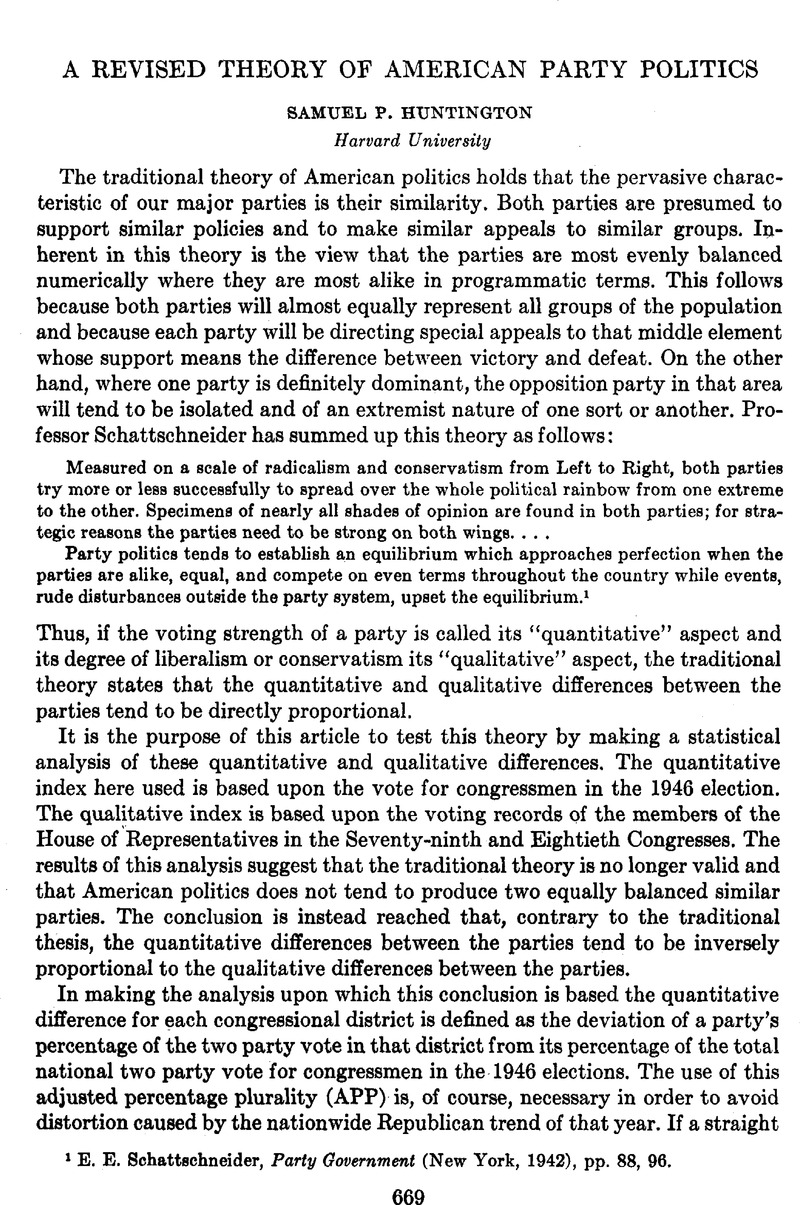Published online by Cambridge University Press: 02 September 2013

1 Schattschneider, E. E., Party Government (New York, 1942), pp. 88, 96Google Scholar.
2 The source for the vote percentages which form the basis for the calculation of the adjusted percentage pluralities is The Gallup Political Almanac for 1948 (Princeton, 1948)Google Scholar, passim.
3 “Facts for November”, New Republic, Vol. 115, Part 2 (Sept. 23, 1946)Google Scholar; “Sold Out: The Story of the 80th Congress,” ibid., Vol. 119, pp. 11–30 (Sept. 27, 1948); Special Supplement, CIO News, Vol. 9 (August 19, 1946)Google Scholar; 1948 Voting Record”, CIO News, Vol. 11 (July 19, 1948)Google Scholar.
4 I am indebted to Mr. Ralph Goldman of the University of Chicago for the basic data on ruralism and urbanism. A ruralism index for each congressional district was computed by Mr. Goldman by counting as rural population units of less than 2,500 people and as urban population units of more than that number, and then calculating the percentage of the total population of the district living in rural units. See Ralph Goldman, “Some Dimensions of Rural and Urban Representation in Congress” (Unpublished M.A. Thesis, University of Chicago, 1948), pp. 39–43Google Scholar, Appendix II. In this article, urban congressional districts are defined as those less than 30% rural, suburban as those 30% to 49.9% rural, subrural as those 50% to 69.9% rural, and rural districts as those 70% or more rural.
5 It will be noted that the total number of congressional districts is only 424. Throughout this study eleven congressional districts are excluded from all calculations: the 18th New York district because it was represented in both congresses by Mr. Vito Marcantonio of the American Labor Party and the 1st, 2d, 3rd, 5th, 6th, 8th, 10th, 15th, 17th, and 19th California districts because the successful candidates in those districts obtained the nominations of both major parties under California's cross filing law.
6 The states are classified into sections as follows: New England—Me., N. H., Vt., Mass.' R. I., Conn.; Middle Atlantic—N. Y., N. J., Pa., Del.; Border—Md., W. Va., Ky., Mo.' Okla.; South—Va., N. C., S. C., Ga., Fla., Ala., Miss., Tenn., La., Tex., Ark.; Midwest—Ohio, Ind., I11., Mich., Wis., Minn.; Prairie—N. D., S. D., la., Neb., Kan.; Mountain—N. M., Ariz., Utah, Colo., Nev., Wyo., Mont., Ida.; Pacific Coast—Calif., Ore., Wash. The quantitative differences are the adjusted percentage pluralities computed from the per cent of the total two party vote for all candidates for Congress in that section received by the majority party in the 1946 congressional elections. Vote statistics are from U. S. Bureau of the Census, Statistical Abstract of the United States, 1948, p. 316Google Scholar.
7 For a description of the qualitative characteristics of the Republican party in the South, see Key, V. O. Jr., Southern Politics in State and Nation (New York, 1949), Ch. esp. pp. 289–297Google Scholar.
8 For the views of one of these conservative prairie Democrats, see Mullen, Arthur F., Western Democrat (New York, 1940), pp. 343–360Google Scholar.
9 Included in this list are Black, Hugo, Arnall, Ellis, Sparkman, John, Mankin, Helen Douglas, Patrick, Luther, Kefauver, Estes, Nixon, Albert Gore. H. C., “Politics of the Hills”, Journal of Politics, Vol. 8, pp. 123–133 (May, 1946)Google Scholar.
10 Schattschneider, op. cit., pp. 80–84.
11 Blumenthal, Albert, Small Town Stuff (Chicago, 1932), pp. 296–306Google Scholar; Hicks, Granville, Small Town (New York, 1946), pp. 183–194Google Scholar; Key, op. cit., pp. 37–41, 87–91, 131–135, 223–224, 246–253, 298–311.
12 See the post-election studies of Roper, Elmo, New York Herald-Tribune, June 19, 1949Google Scholar, and the Survey Research Center, A Study of the Presidential Vole: November 1948 (Ann Arbor, 1949)Google Scholar.
13 New York Times, November 10, 1949.
Comments
No Comments have been published for this article.